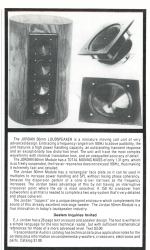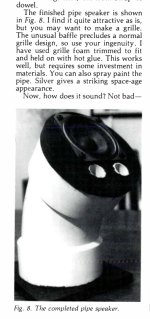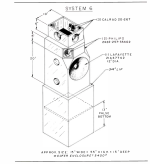The Genelec 1024A was in production between 1979 and 1986.
The Avalon acoustic Ascent started production in 1986.
I always thought that Avalon was first for those deep bevels for better acoustic baffle for the time, but was Genelec actually first?
Was there examples of someone doing this even before?
I think Avalon was first for doing tilted baffle to time-aling, but is this true as well?
Just interested in this, since my baffle tests have moved into this direction..

The Avalon acoustic Ascent started production in 1986.
I always thought that Avalon was first for those deep bevels for better acoustic baffle for the time, but was Genelec actually first?
Was there examples of someone doing this even before?
I think Avalon was first for doing tilted baffle to time-aling, but is this true as well?
Just interested in this, since my baffle tests have moved into this direction..
Interesting subject 🙂. This is a studiomonitor developed in-house at Norwegian Broadcast Corp, 1978. It was done in collaboration with Bjørn Børja at SEAS and Xelex from Sweden. (Later Adyton produced amps). It was an active system, so one amp/125w per driver. Project was initated 1972 due to lack of good studio monitors, according to the development paper. Prototype came 1975, and further development took another year or two, before production started, May 1978.
Gotta pin down your terminology here, do you want the history of beveled baffles specifically, or physically time-aligned baffles in general?
Several classics used stepped baffles for time alignment, the most famous being the Dahlquist DQ-10. Or the Tangent RS-8, same stepped face.
But if the quest is the history of slanted baffles for time alignment, as opposed to stepped baffles, ladies and gentlemen I give you the Spica TC-50. It's ALL slant.

Several classics used stepped baffles for time alignment, the most famous being the Dahlquist DQ-10. Or the Tangent RS-8, same stepped face.
But if the quest is the history of slanted baffles for time alignment, as opposed to stepped baffles, ladies and gentlemen I give you the Spica TC-50. It's ALL slant.
Im more interested in overall history of using slant/tilt and bevels on baffle.
Maybe part of this is, that when you do certain kind of bevels and tilt your speakers, it's always said that its "avalon style" like they invented it.
But this thread shows that this is not the case, both concepts were already invented by 1986.
(Spica released that speaker by 1983.)
Tilting baffle for time-alingment and deep bevels Avalon just loaned and used both concepts at the same time.
(and popularised the idea..)
Maybe part of this is, that when you do certain kind of bevels and tilt your speakers, it's always said that its "avalon style" like they invented it.
But this thread shows that this is not the case, both concepts were already invented by 1986.
(Spica released that speaker by 1983.)
Tilting baffle for time-alingment and deep bevels Avalon just loaned and used both concepts at the same time.
(and popularised the idea..)
Probably neither. Maybe commercially thou.
I was building heavily beveled loudspeakers in the late 70s, i likely got the idea from Speaker Builder, Wireless World, or AES Journals.
This is only the tweeter pod and not many were sold but from the late 70s.

dave
I was building heavily beveled loudspeakers in the late 70s, i likely got the idea from Speaker Builder, Wireless World, or AES Journals.
This is only the tweeter pod and not many were sold but from the late 70s.
dave
These days many might bevel their edges but not time align. They really are different things although their popularity shared an overlap.Im more interested in overall history of using slant/tilt and bevels on baffle.
If you can find any of those old magazines, articles, or know could one look them up online, i would be interested..Probably neither. Maybe commercially thou.
I was building heavily beveled loudspeakers in the late 70s, i likely got the idea from Speaker Builder, Wireless World, or AES Journals.
This is only the tweeter pod and not many were sold but from the late 70s.
dave
I could find some on this archive: https://www.worldradiohistory.com/Archive-All-Audio/Speaker-Builder.htm
Interesting stuff:



Interesting stuff:



Last edited by a moderator:
I mean, at some point people had to build their own speakers (like computers) before they could buy it off the shelf, or before there was globalisation/trade which made it more affordable to buy, than build their own right?
So I suspect these ideas came around the same time. Richard Vandersteen released the Model 2, a minimally baffled, time aligned speaker since 1977:


No doubt the development for these came in the 1970s.
Reference:
https://www.erinsaudiocorner.com/loudspeakers/vandersteen_model_2/
with thanks @bikinpunk
So I suspect these ideas came around the same time. Richard Vandersteen released the Model 2, a minimally baffled, time aligned speaker since 1977:
No doubt the development for these came in the 1970s.
Reference:
https://www.erinsaudiocorner.com/loudspeakers/vandersteen_model_2/
with thanks @bikinpunk
Last edited:
Vandersteen used 1st order filters (look at step response). Perhaps it is the main reason for strange sound, lots of comb filtering and cone resonances?
In his last interview Vandersteen said that he'd like to use multiway-dsp with it... (unable to find a link now)
My AINOgradients are 4-way with 2nd order acoustic slopes, done with dsp. AINOs are dipole but also the wide vertical distribution of drivers must be a factor behind the spacious sound, very pleasant for classical, but not so good for speech (as tv monitors). Very different sound compared to coaxial 2-ways!
In his last interview Vandersteen said that he'd like to use multiway-dsp with it... (unable to find a link now)
My AINOgradients are 4-way with 2nd order acoustic slopes, done with dsp. AINOs are dipole but also the wide vertical distribution of drivers must be a factor behind the spacious sound, very pleasant for classical, but not so good for speech (as tv monitors). Very different sound compared to coaxial 2-ways!
Several cost reasons for that, and IIRC they weren’t exorbitantly priced when introduced, certainly as compared to other big names. Loved mine - particularly with their sub and passive XO, but the merry go round of FOMO/upgrade-itis was very strong from the mid ‘70s until, well, honestly only just early this century. 🙂
they weren’t exorbitantly priced when introduced
Hard ro recall. $800-1000 CAD? Simialr price to TLS80s.
dave
The DQ-10 pictured is either a much newer pair or an earlier pair (painstakingly) mirror imaged. I did more than a few of those. Made a big difference and why they didn’t do it from the start…
Probably too much trouble to inventory pairs.
But if the quest is the history of slanted baffles for time alignment, as opposed to stepped baffles, ladies and gentlemen I give you the Spica TC-50. It's ALL slant.
John Bau is a member here. Maybe he will comment.
- Home
- Member Areas
- The Lounge
- History question: Who made first deep bevels on speaker? Was it Genelec or Avalon or?...